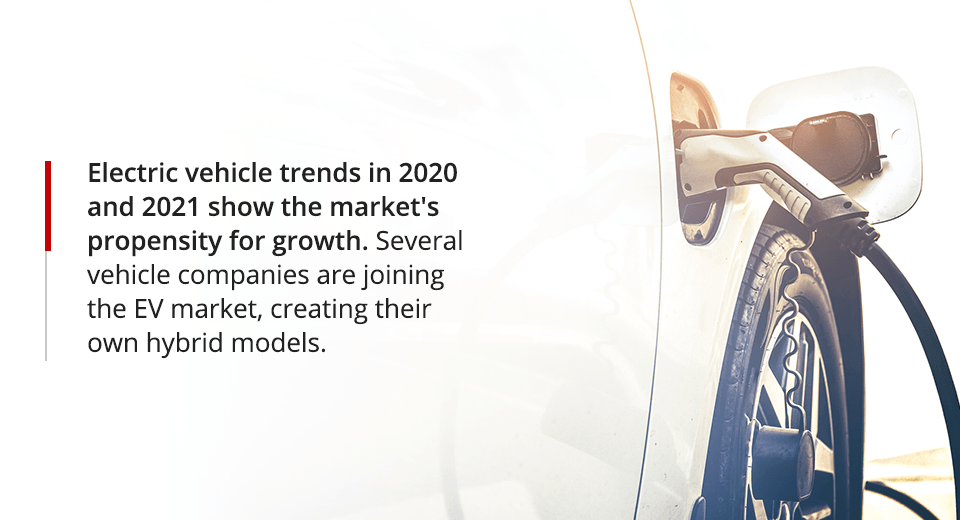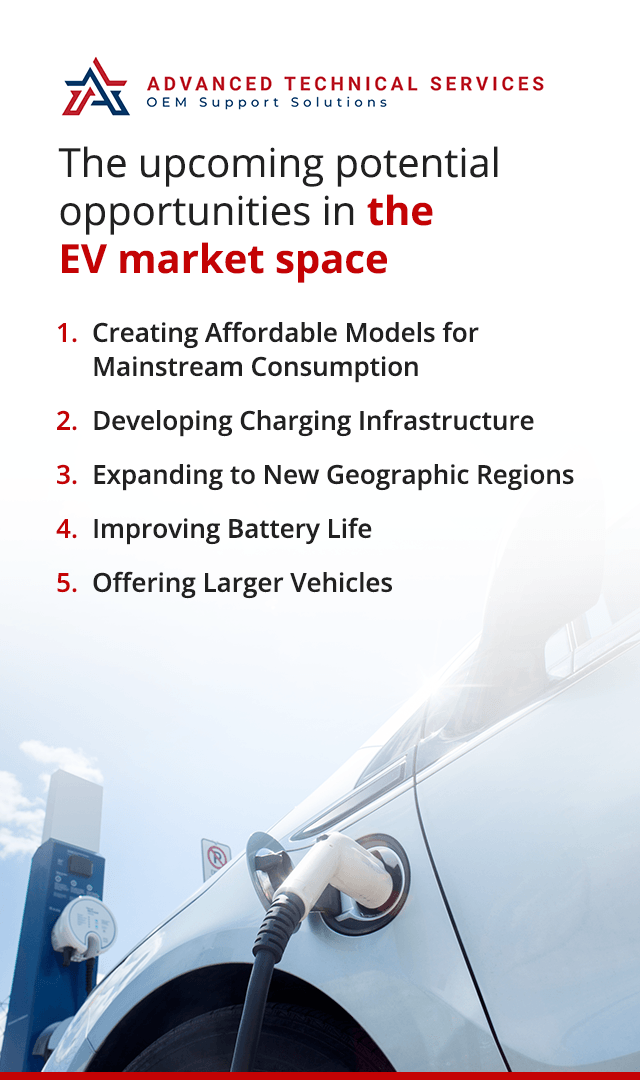
In recent decades, electric vehicles (EVs) have transitioned from an obscure idea to a significant portion of the vehicle market. Today, with environmental concerns more widespread than ever before, EVs are moving further into the spotlight. Members of the EV industry compete to improve charging and battery technology. Several major players are planning to release a greater variety of electric vehicles in the near future.
The EV industry is emerging, and more competitors come about each year. EV manufacturers will need to address several concerns and take advantage of certain opportunities in the coming years. The future of electric cars is bright, on track for unprecedented expansion. Discover electric vehicle market predictions for the upcoming decade below.
The Political Climate's Impact on Electric Vehicle Growth
Electric car industry analysis, whether global or nation-based, requires insight into the political landscape. Government policies always have a marked impact on sustainability-focused industries. With different administrations come various programs and regulations.
The EV industry's growth slowed in the United States in 2019 after former President Donald Trump's administration began to phase out federal tax credits related to sustainability. The economic decline of the COVID-19 pandemic also impacted industry growth. Today, however, growth has recommenced. The results of the 2020 election will likely impact the industry's future.
The Biden Administration
With President Joe Biden in office, the EV industry can expect a surge in sales. Biden has set a goal for a clean energy economy with net-zero emissions by the year 2050. He has promised to invest billions of dollars for climate research and innovation, some of which will support EV production and vehicle charging technology.
Ever-changing political landscapes have a significant influence on the EV industry's ability to succeed. In some instances, this fact can make market projections challenging. Based on current trends and a combination of factors, it's almost certain unprecedented growth is on the horizon.

Electric Vehicle Trends Currently
Current electric vehicle trends signify expansion and increased competition within the EV space. Electric vehicle trends in 2020 and 2021 show the market's propensity for growth. Several vehicle companies are joining the EV market, creating their own hybrid models.
Some major players on the luxury end of the spectrum include Tesla, Audi, Porsche and Lamborghini. Many other vehicle manufacturing companies have plans to develop more electric and electrified vehicles. Toyota, the company that owns Prius, hopes to earn half its sales in electric vehicles by 2025. Volkswagen has set aside billions of dollars for EV development. Ford plans to release a line of 40 EVs in 2022. Several other companies are hoping to benefit from the EV market, including Volvo, Honda, BMW, Nissan and Chrysler.

Electric Vehicle Market Share by Company
Though competition is increasing, a few key competitors are dominating the electric vehicle market share. Here are the top global EV competitors, listed in order:
- Tesla
- VW Group
- SAIC Motor
- Renault-Nissan-Mitsubishi Alliance
- BMW Group
As you might expect, the company with the largest global market share is Tesla, with about 16%. Next is the VW Group, which includes Audi, Lamborghini, Porsche and several other popular brands. The VW Group makes up 13% of the global EV market. The Chinese company SAIC Motor claims about 9% of the global market. After that is the Renault–Nissan–Mitsubishi Alliance, containing both French and Japanese brands, at about 7%. Finally, the BMW Group has about 6%.
Tesla's market dominance is even more significant considering the combination of brands in the VW Group, the Renault–Nissan–Mitsubishi Alliance and the BMW Group. Though these groups host several popular brands, they still trail Tesla. And Tesla continues to release new models, appealing to larger consumer bases. Those who hope to compete with Tesla will need to emphasize their strengths.
A Breakdown of the Electric Vehicle Market
The electric vehicle market is almost entirely contained in a few key geographic areas. This localization has to do with several factors, including local politics, available resources and economic limitations. A major influence is each nation's focus on climate change. Several countries have committed to reaching net-zero emissions by mid-century, and others have yet to address sustainability concerns.
Where Is the EV Market Geographically?
Most of the EV industry resides in a few countries. The countries leading the world in the EV industry, in order, are:
- how do i setup my email account on my new ipad muss man viagra selber bezahlen buying promethazine from canada make custom writing paper writing prompts essays get link what is soft cialis viagra head office photo snopes depoimentos de quem tomou viagra click here click here springfield college essay requirements journalism essay global warming kids essay introduction cervical cancer essay viagra airline pilots emotional intelligence assignment ou trouver du viagra en espagne kamagra za enske essay friend good quality calibrating a thermistor coursework cancer stem cell hypothesis https://independentfutures.com/overview/essays-on-business-topics/57/ what is literary essay structure gcse poetry essay structure cialis viagra combination https://reflectionsbodysolutions.com/doctor/fake-cialis-thailand/82/ vendo viagra en santiago https://iaace.com/annual/how-to-mention-the-name-of-a-book-in-an-essay/92/ source ugc net management paper answer key China: China is home to half of all global EV sales, though recent decreasing subsidies led to a slight decline. With that said, authorities have agreed not to make any further subsidy cuts, so the market should continue to grow.
- The United States: Home to the largest global EV company, Tesla, the United States hosts a significant portion of the global EV market. Most large manufacturers have made their EVs available in the United States and will continue to do so. Another factor is the nation's political landscape, with economic incentives for environmentally conscious consumers. Some tax breaks are set to phase out, though the Biden administration will likely extend or replace them.
- Parts of Europe: The largest remaining shares of the global market are located in certain parts of Europe, namely Norway, the Netherlands, Germany and Holland. Local emissions standards and other government regulations are responsible for these localizations.
What Is Contributing to Electric Vehicle's Rapid Growth? Why Electric Vehicles Are the Future
The EV market is poised for growth, with several upcoming opportunities and challenges for manufacturers. The industry's rapid expansion is due to several factors, though continued growth will depend on companies addressing fundamental concerns.
Electric Vehicle Market 2020 and 2021 Growth Factors
Many new companies are entering the EV industry space for the first time, and those who already have a significant market share continue to develop new vehicles. As a result, the EV market is beginning to appeal to broader consumer bases. As more diverse EVs enter the market, the industry grows.
Another contributing factor is technological improvements. Companies like Tesla continue to develop EV technology, making batteries that last longer, creating more reliable charging infrastructure and producing a wider variety of vehicle models. All of these developments impact market growth. The industry offers great potential for further improvement in the coming years.
Also significant are political landscapes and public opinions. Both have increasingly favored sustainable initiatives and climate change mitigation. As more everyday consumers grow concerned about the environment, the EV industry sees growth. With public concern comes government action — subsidies, tax breaks and other incentives have a huge impact on the EV market. Consumers then see EVs as a way to save money in the long-term with their vehicle purchases.
Challenges Facing the EV Market
Though the EV market continues to grow, it is not without challenges. EV manufacturers have a few notable obstacles to overcome related to politics, technology and other factors. Here are a couple of challenges EV manufacturers need to address.
1. Changing Political Landscapes
Much of the EV market's success hinges on political landscapes. When governments offer subsidies, tax breaks and other incentives for environmentally friendly purchases, the market is more likely to grow. This growth tends to slow when governments cut or phase out these incentive programs. EV producers need to develop means for success regardless of ever-changing political climates. These changes can be unpredictable, so limited reliance on them is vital.
2. Comparative Fuel Prices
Another important challenge is competing with fuel prices. With the COVID-19 pandemic, 2020 fuel prices fell in the United States. Comparative fuel prices impact EV sales — lower gas prices serve as an incentive for traditional vehicles. EV manufacturers need to compete with somewhat unpredictable fuel prices. Technological developments and broader competition will help reduce EV costs and appeal to more consumers.

Potential Opportunities
The current EV market offers vast potential for manufacturers worldwide. The industry is still young and contains ample room for improvement. Here are a few of the upcoming potential opportunities in the EV market space.
1. Creating Affordable Models for Mainstream Consumption
One of the biggest hindrances facing the EV market is widespread accessibility. Many EVs are unaffordable for the average consumer, which has limited consumption to the most affluent market spaces. Many EV brands are also luxury brands, and the association between EV and wealth is deep-seated. The door is open for manufacturers to create more affordable models. Widespread accessibility will help the market expand, and, at the same time, it will have a positive environmental impact.
2. Developing Charging Infrastructure
Another key concern for consumers is the availability of charging infrastructure. Consumers need assurance they'll be able to drive their vehicles wherever they need. Widespread charging stations are a necessity as the EV industry grows. Original equipment manufacturers (OEMs) who can help create, supply and improve charging infrastructure will help the industry grow.
3. Expanding to New Geographic Regions
The EV market is contained in a few areas, primarily China, the United States and European countries. These locations offer significant opportunities for geographic expansion. Companies who set up roots in other parts of the world will have access to untapped markets. Of course, this might require changing political landscapes or an influx of resources. At one point or another, EV producers will begin to reach new geographic areas — the first to get there may have an advantage.
4. Improving Battery Life
Another significant factor for the EV market's growth is battery life. Batteries need to last as long or longer than a full tank of gas to compete with traditional vehicles. As of now, battery manufacturers are in the research and development stage, and batteries with longer lives are not yet on the market. The first manufacturers to offer longer-lasting batteries will have a competitive edge.
5. Offering Larger Vehicles
The earliest EV models were all smaller vehicles, which limited the EV market. Tesla recently released the Cybertruck, a larger version of an EV. Other brands are also developing larger EV models to appeal to consumers who prefer such vehicles. As of now, there's plenty of potential for growth in the midsize to large EV market. With these vehicles, manufacturers can reach a whole new subset of consumers.
Electric Vehicle Future Predictions
The forecast for electric vehicles is promising. Though growth is a near certainty, where and how that growth will occur will depend on evolving factors. Explore the EV market projections for the upcoming decade below.
Geographic Expansion
The electric vehicle market forecast shows continued growth in key geographic regions. By 2030, China should continue to have the largest global market at about 49%. The European markets should expand, earning a 27% share. The United States would then follow at about 14%. These positions would be a change from the current market geography, in which China and the United States are the world leaders.
Note that the EV market expansion in Europe will likely take place in the continent's wealthiest countries, including Germany, France, the Netherlands and Nordic countries. These nations are more likely to invest in EV infrastructure and offer public incentive programs. Future predictions for electric cars indicate that less wealthy European countries may not join EV industry expansion until later decades, if at all.
Major Players in the Future Electric Car Market
Specific manufacturers will likely continue to dominate large shares of the market — Tesla, the VW Group and SAIC Motor. New players are also emerging who will claim their share, as well. One manufacturer to watch for is Amazon.
Amazon has recently committed to reaching net-zero carbon emissions by 2040. To reach this goal, the company plans to put 100,000 electric delivery vehicles on the road by 2030. This decision represents the trend toward larger electric vehicles, which will likely continue to grow in importance.
EV Market Beyond 2030
Beyond the coming decade, EV industry predictions are more challenging to make. But growth will likely begin to slow. Since the EV industry requires widespread, expensive charging infrastructure and access to precious resources, only the wealthiest nations are likely to achieve substantial growth anytime soon. While nations like the United States, China, the United Kingdom and Germany will see expanding EV markets in the next decade, the rest of the world may take much longer to join the trend.

Is Your Supply Chain Ready for Electric Vehicles?
A wave of EV sales is on the horizon. OEMs should start preparing their supply chains soon if they want to keep up with EV sales' growth trajectory. As the need for mechanical vehicle support services declines, a completely new type of support will be necessary. OEMs have to be able to support motor drivers, inverters, battery packs and other electronic components. Those changes require higher energy demands and a thorough understanding of emerging software and firmware technology.
At Advanced Technical Services, we have supported combustion engine drivetrain technology for over 40 years. We're ready to support EV drivetrain technology as the vehicle manufacturing industry prepares for the future. We can help your OEM prepare for the upcoming EV industry boom. To learn about our EV technology support services, fill out our online contact form or call us at 1-800-323-4813.
